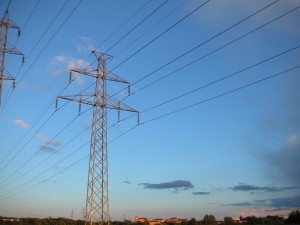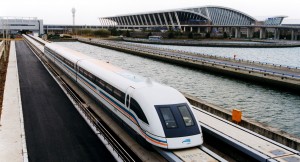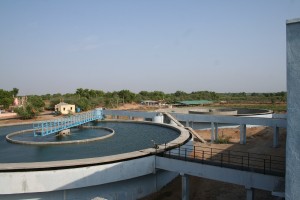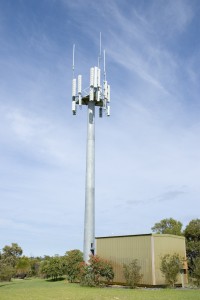Introduction to the domains
Course subject(s)
Module 1: Complexity of Infrastructure
In the coming modules, we will focus on four infrastructure domains: energy, transport, water and information and communications technology (ICT). In this section we will introduce these domains to you. In the next section, we will look at these domains from a more theoretical perspective.
Energy

Energy is a basic need for modern society, because it provides us with heat and light.
Energy is also the key resource for other infrastructures. Electricity is needed to power broadcasting towers, internet routers, traffic lights, pumps in transmission networks and many other infrastructure related appliances.
But where does this energy come from? Today, our primary energy usage still relies heavily on a variety of ‘fossil’ fuels, such as petroleum, natural gas and coal. However, thanks to a great many technological innovations in the 20th century, this might change due to the introduction of for instance wind, solar, hydro and nuclear power.
The energy industry is highly dynamic. We would like to highlight three developments that are of importance right now.
1. Sustainability
Globally, an increasing number of governments are trying to combat climate change by reducing greenhouse gas emissions from burning fossil fuels. This means a transition from fossil fuel dependency towards the use of more renewable energy sources. Related to this trend is the increasing role of natural gas in energy systems, because it has a lower carbon intensity and allows for flexible energy supply to mitigate the intermittent energy supply coming from for instance solar and wind energy.
2. Introduction of the market paradigm in the energy sector
The energy industry is getting more and more fragmented from an institutional perspective. The 20th century energy industry was largely centralized, vertically integrated and entirely state-owned. Today, the industry is a lot more complex, at least in most Western countries. Energy companies, which used to be state-owned, are being privatized and vertically integrated companies are being unbundled to allow for competition in the energy sector. This is also called liberalization. Moreover, related to the first trend we see a trend of decentralization in the energy sector were consumers are also becoming producers of energy (e.g. solar panels on the roof of households, or the application of small scale wind energy).
3. Innovations throughout the energy sector
Moving in parallel with the previous two developments, the energy industry is confronted with various technological innovations. Think about photovoltaic cells, micro combined heat and power, electric vehicles or “smart-grid”.
The trend towards sustainability, the introduction of the market paradigm and the sprout of innovations have resulted in a great many challenges for then energy sector. Moreover, these developments and challenges require enormous investments in the energy infrastructures in the near future. We will discuss all of this extensively in the MOOC.
Transport

A second domain of infrastructures are transportation infrastructures. Our ability to transport ourselves and our goods over these infrastructures is considered one of the characteristics of advanced societies. Various technologies and infrastructures provide a wide range of individual and collective transport services, some of them privately funded, others publicly funded. Think about roads, railways, waterways, airways, but also ‘pipelines’.
The key development here is the ongoing growth in demand for transportation. This creates new problems. We have to cope with these problems in conditions that are totally unlike those prevailing 10 to 20 years ago. The introduction of the market paradigm and the subsequent institutional fragmentation have changed the scene. At least three challenges are worth mentioning at this point.
First, there is the challenge of congestion. Transportation infrastructures clog up as a result of the increased demand for mobility. Trends such as urbanization further accelerate this problem.
Second, transportation infrastructures also face the challenge of the need to become more sustainable. Particularly in areas where future growth is to be expected.
Third, also in this sector technological innovations are changing the sector. Many of these innovations have sprouted to address the issues of congestion and sustainability. A key characteristic of the transport sector making changes to the sector more difficult is that changes have to be implemented in a continuously functioning transportation infrastructure. New concepts such as dynamic traffic management or new business models need to be implemented without interrupting the services of these infrastructures. A huge challenge. In this MOOC, we will pay attention to all these challenges.
Water

Because of population growth and economic development, water resources in many parts of the world are pushed to their natural limits. In turn, the ability of cities and countries to grow, attract investment, meet the fundamental needs of populations and ensure environmental protection will be increasingly threatened if water resources are not smartly managed. This excellent video summarizes the main challenges in the domain of water.
Information and communications technology

Information and communications technology related infrastructures are the fourth domain of infrastructures that we identify in this MOOC. Telecommunication allows for various modes and forms of information exchange. It allows for long-distance communication, for entertainment purposes and for accessing information. Different technologies and infrastructures have evolved to provide these services. Think about television, radio, and telephone infrastructures, and think about the Internet of course.
The dominant trend is the increasing Internet-based nature of technology that is employed in all of these infrastructures. This so-called technological convergence in telecommunication creates a number of challenges.
A first challenge concerns how we can or should make use of the enormous influx of innovations within these highly dynamic infrastructures. How to deal with an ‘app-based-economy’ where consumers also become producers, or with the development of personalized entertainment and television, location-free communication, online banking, online learning, or even online democracy. All require careful consideration before implementation.
A related challenge is that of business models. Developing successful business models for the virtually endless possibilities of telecommunication infrastructures is a challenge in itself. Ensuring that the interests of both companies and consumers are met only makes this challenge harder.
The final challenge here discussed concerns allowing for internet-based telecommunication in a secure way, whatever its shape or for. This security, often dubbed ‘cyber security’, is of paramount importance.

Next Generation Infrastructures by TU Delft OpenCourseWare is licensed under a Creative Commons Attribution-NonCommercial-ShareAlike 4.0 International License.
Based on a work at https://ocw.tudelft.nl/courses/next-generation-infrastructures/.



